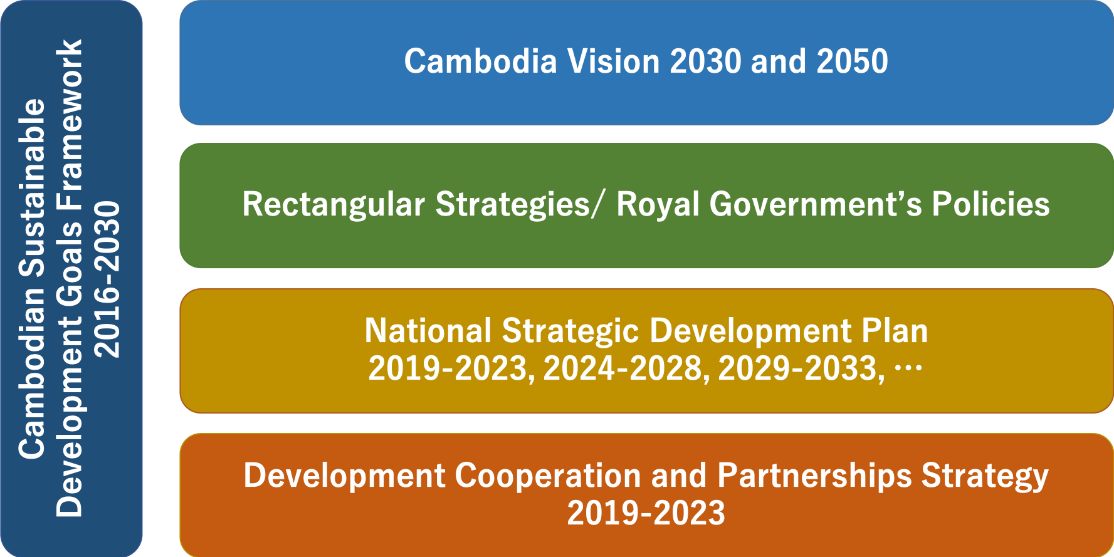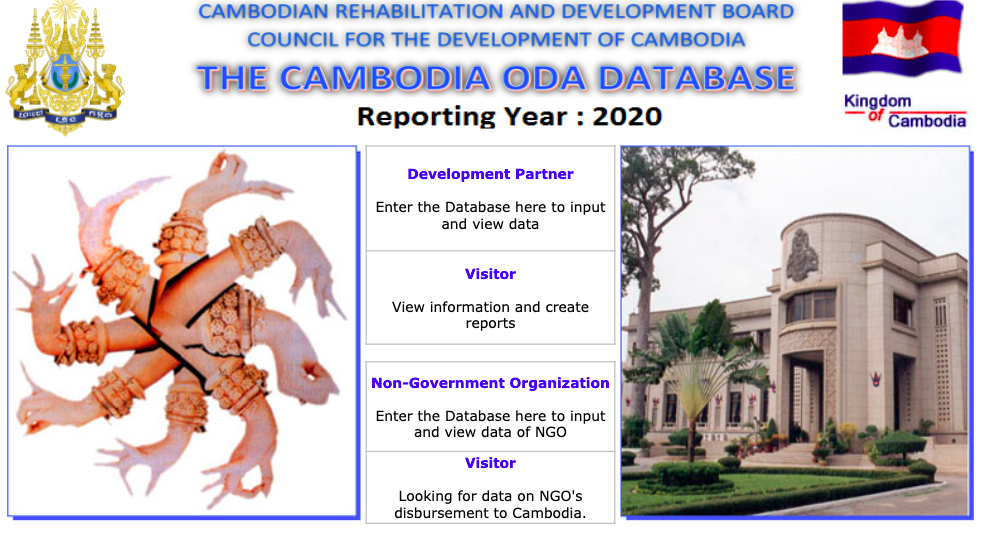Cambodia’s Development Strategies
Development planning in Cambodia means being guided by a number of key strategies; ranging from medium and long-term development plans namely the Cambodia Vision 2030 and 2050, to a clear socio-economic and political development agenda set out in the Rectangular Strategy for Growth, Employment, Equity and Efficiency – Phase IV with its operational plan outlined in the National Strategic Development Plan.
More specifically, Cambodia has a Development Co-operation and Partnerships Strategy 2019-2023 that links development planning to resources by highlighting the different forms of development finance that need to be mobilized and managed, through effective partnerships mechanisms and tools, in order to achieve Cambodia’s development goals.

Integrating Global Partnership Indicators for Timely Tracking: The ODA Database
As part of the Development Co-operation and Partnerships Strategy 2019-2023 and Cambodia’s ongoing commitment to track progress on the principles of effective development co-operation, Cambodia uses its Aid Information Management System (AIMS) - the Cambodia ODA Database - to report progress on key indicators on an annual basis.
In 2018, Cambodia incorporated several indicators from the Global Partnership monitoring framework into its development policies and monitoring systems to track their progress. Five Global Partnership indicators are embedded in the results framework of the Development Co-operation and Partnerships Strategy 2019-2023, including indicators that measure the use of country results frameworks (SDG 17.15.1) and country public financial management and procurement systems by development partners, as well as indicators that assess the proportion of aid on budget and the annual and medium-term predictability of aid.
The Global Partnership indicator on gender-responsive budgeting, SDG indicator 5.c.1, has also been included in the Cambodian SDG Framework for tracking the SDG's progress in the country. The Government is in the process of preparing guidelines for line-ministries and government agencies on how to include gender mainstreaming efforts when implementing program-based budgeting. Through its National Strategic Plan Neary Rattanak V 2019-2023 for Strengthening Gender Mainstreaming and Women’s Empowerment, Cambodia also plans to support selected ministries and agencies to develop and use specific tools and methods to track gender-responsive budgeting.
Annual reporting on these Global Partnership indicators in Cambodia is possible as the indicators are embedded in the country’s ODA Database. For this database to provide accurate and timely information, development partners including NGOs are required to report their data at the project level to the database twice a year; once to validate development co-operation from the previous year, and then to confirm the year’s disbursements and provide projections for the following years.
The database is a single-country owned data source that allows comprehensive and evidence-based analysis of ODA trends and its alignment to national priorities.

Why were we successful in integrating Global Partnership indicators in our country database?
- Cambodia’s strong political commitment to the principles of effective development co-operation is a key factor in the success of integrating Global Partnership indicators into national policies and monitoring processes. In addition, strong relationships and partnerships with development partners were essential in ensuring that they report, update the data and cooperate in validating the data in the Cambodia ODA Database regularly.
- When integrating indicators into the national strategies and policies, timing appears to be a critical success factor. Cambodia decided to integrate the Global Partnership indicators in the Cambodia ODA Database in 2018, well before 2019 when the indicators were finally incorporated into the National Strategic Development Plan 2019-2023 and the Development Co-operation and Partnerships Strategy 2019-2023.
- A systematic working procedure with appropriate tools and mechanisms in place should be instituted to keep data updated and ensure that timely monitoring is possible. With the Cambodia ODA Database, data entry, validation and reporting cycle have become an integral part of the systematic working arrangements with development partners.
- The national results framework needs to be comprehensive and have backing from in-country development partners to ensure timely and high-quality data is reported by them. In order to build such a framework, it is important to meaningfully engage development partners and the relevant stakeholders at the country level.
Cambodia has strengthened its partnerships for sustainable development by going beyond planning and strategizing and into real-time tracking of key SDG indicators such as those around effective partnerships (SDG 17) and gender equality (SDG 5). We hope this will serve as a useful, practical case study for other countries in the region and globally.
